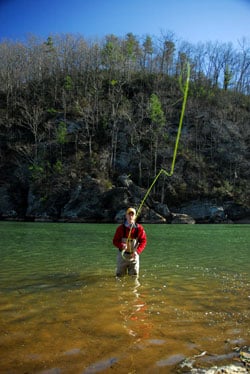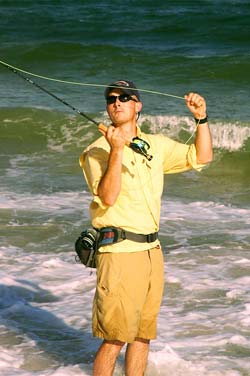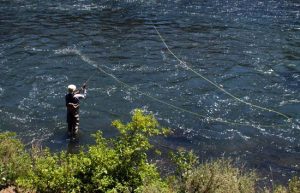Fly Casting Tips
The Basics
Rod Assembly Always check to be sure that your guides are properly aligned when putting a rod together, that your line has not missed a guide, and that the ferrules are well-snugged-together. Misaligned or missed guides are common when you are rushing to reach the water.
Gripping Fly Rods Grip a fly rod with a slightly extended index finger and with your thumb directly on top, opposite the fly reel. The amount of pressure you need to properly grip the rod will vary from very light with small trout rods to something equal to a strong handshake with 11-weight and larger rods, but always keep your grip as relaxed as possible.
Help Your Fly Line “Forget” All fly lines have “memory” — something most often seen in the form of coils when line is first stripped from a reel, especially stiffer lines made for warmer weather and distance casting. Taking the time to stretch your line in your hands after pulling it off of the reel will improve your casting distance and make it less likely that the loops of your fly line will tangle in the water or the bottom of the boat.
Changing Direction To change the trajectory of your cast merely change the trajectory of your casting hand on your forward or backcast. Line trajectory and hand trajectory are usually the same.
Wind-Resistant Casting To throw tighter, less-wind-resistant loops, concentrate on stopping the rod abruptly at the end of each casting stroke.
Preventing Tailing Loops The best and most consistent way to prevent “tailing” loops and the resultant “wind knots” is to concentrate on casting as smoothly as possible and don’t cast harder/faster than you need to.
Learning to Mend When learning to mend a fly line — throwing the line upstream or downstream after the fly hits the water to eliminate drag — start with your rod tip low and mend with authority, lifting your rod high. You want to move as much line as necessary to reach the point at which the current is pulling your line in the wrong direction.
Reach Before You Mend End any cast that you know you will have to mend with an upstream reach cast, presenting the fly downstream of the line. Perform a reach cast by sweeping the rod either right or left just after delivering the forward cast and before the fly hits the water. Even if the situation doesn’t require a mend, the reach cast gives your fly a “head start” on the fly line and delays the onset of drag.
Wrong Wind Direction Wind blowing from the wrong direction? Try presenting your fly by dropping your backcast, or better yet learn to cast over your opposite shoulder.
Dealing with Strong Winds When casting in heavy winds, line speed is the key. Casting with more line than usual out of the rod tip, double hauling, and using water tension to help you load the rod faster and make fewer false casts (“water hauling”) are all helpful.
Saltwater Casting Distance Most saltwater fly fishing requires casts of no more than 50 or 60 feet and many fish are hooked when they are 30 feet away. Equally, if not more, important than the distance you can cast: the speed at which you can deliver the fly, your “situational awareness” about the fly line at your feet, and your ability to pick up and make additional casts to the fish if your first cast is off the mark.
Eliminate Lost Motion Try to eliminate all those creators of “lost motion” in your fly fishing: extra false casts, not keeping enough line out of the rod tip, and forgetting to position yourself where you have the best opportunity to make a good presentation.
De-Bugging Your Casts
Watch Your Backcast Having trouble casting? Turn and watch your back cast — it’s often the culprit. Common problems are throwing the backcast too low and not waiting for the loop to fully extend before beginning your forward cast.
De-Bugging Roll Casts Roll casts often suffer because the line is not cast in the same plane as the line is lifted. Be sure to align your lifting action and the forward casting stroke.

You will almost always cast more accurately by keeping your rod as perpendicular as possible and by casting with the rod hand more in front of the body to align it with your eyes. photo by Zach and Lauren Matthews | www.itinerantangler.com
Line Twist Many casters unknowingly put twist in their fly lines because their backcasts are canted to one side, making a fly rod tip travel in a circle as they complete their forward cast. Bulky flies can also spin and add twist. There are two effective ways to remove fly line twist. One is simply to spin the fly line between thumb and forefinger in the opposite direction of the twist. The other is to false-cast a number of times while consciously reversing the direction of the circle made by the rod tip (e.g. overhead backcast and sidearm forward cast).
Preparing to Shoot Line When shooting line — either in saltwater or when using shooting tapers for salmon and steelhead — line management is everything. Develop a sixth sense for where your uncast line is.
Over-Lining a Rod You can make a rod’s action “slower” by overlining the rod with a fly line rated one size higher. Overlining rods often helps beginners get a better feel for when a rod loads.
Casting Accuracy Most casters naturally cant their casting stroke to the side to help prevent tailing loops, but you will almost always cast more accurately by keeping your rod as perpendicular as possible and by casting with the rod hand more in front of the body to align it with your eyes. (See “The Mechanics of Accurate Casting.”)
Casting Instructors Good casting instructors are worth far more than they charge. Consider professional golfers, who are constantly coached by private instructors, most of them players with lesser ability but with valuable skills in analyzing and correcting mistakes. If you can’t find or afford an instructor, try video-taping your casts.
Cool Techniques
Clearing Debris from a Fly Use the “stutter pickup” to rid the fly of hitch-hiking algae, grass or surface scum. On the pickup raise the tip, drop it, and immediately resume the pickup.
Casting Large Flies When casting flies that are heavier or larger than what your line and rod were designed for, try putting a side-arm motion in your back cast and making a straight overhead forward cast. This is sometimes referred to as a “Belgian” cast and can also help when the wind is blowing over the wrong shoulder. Be aware, though, that this style of casting will also put twist in your fly line. (See “The Belgian Cast.”)
Short- vs. Long-Distance Casting Weight-forward (WF), shooting taper (ST) and double-taper (DT) lines all cast about the same at close range, but WF and ST lines will cast farther for most casters. Once their heavy “head” is out of the rod the small diameter running or shooting line shoots farther, and being able to feel when the head is out of the rod tip is a fundamental skill in distance casting.
Best Lines for Roll Casting Double-taper lines are easier to roll cast at longer distances, since the larger-diameter line “belly” is still in the rod tip. However, weight-forward lines will cast just as well as double-taper lines at short distances, or until you get the head out of the rod tip.
The Slide Pickup If you find yourself with not enough line out of the rod tip as you begin a new cast, trying letting a small amount of line slide from your fingers as you start your next backcast, then quickly stop the line from going out so that you can load the rod. (See “Beyond Competence, Part I.”)
The Roll-Cast Pickup One of the most useful techniques in fly casting. Roll cast to lift your line off of the water, then begin your backcast as the line straightens out in front of you. This technique has multiple uses, including speeding up fly delivery, “aerializing” a long section of fly line to reduce surface tension, and lifting your fly away from debris or obstacles. (See “Beyond Competence, Part I.”)

Double-hauling gives you more line speed — and therefore more casting accuracy in high-wind conditions. Learn it by laying the fly line down on both the forward and backward casts and pausing between each haul. photo by Zach and Lauren Matthews | www.itinerantangler.com
Learning to Double Haul The easiest way to learn to double haul — which requires hauling on both the forward and backward casts in succession — is to practice a single haul in both directions, letting fly line fall to the water or grass before you start forward or back again. As long as you remember to bring your line-holding hand back to the rod after it “bounces” below your waist, and as long as your fly line lands straight, you should have no problem picking up your line again.
Using a Single Haul A haul is a pull or tug on the line that is normally done during the backcast or the forward cast. It increases the speed of the line, enabling you to make longer casts with less strain on your casting arm. You can also use it during the pickup to ease the line off the water with a shorter stroke than you’d normally need. (See “Beyond Competence, Part I.”)
High-Sticking The more fly line that touches the water, the greater the chance of drag affecting your fly. That’s why longer rods with longer leaders and “high-sticking” — keeping the rod tip high and extended while fishing close to the target — is a deadly nymphing technique.
Using a Sidearm Cast Most fly fishers only think of the sidearm cast as allowing them to cast under overhanging trees and bushes. But it is also a potent slack-line cast because it lets you put curves and slack in the line. If you overpower the sidearm cast, the fly tends to kick (curve) to the side in the direction in which you are accelerating the rod. (See “Beyond Competence, Part II.”)












